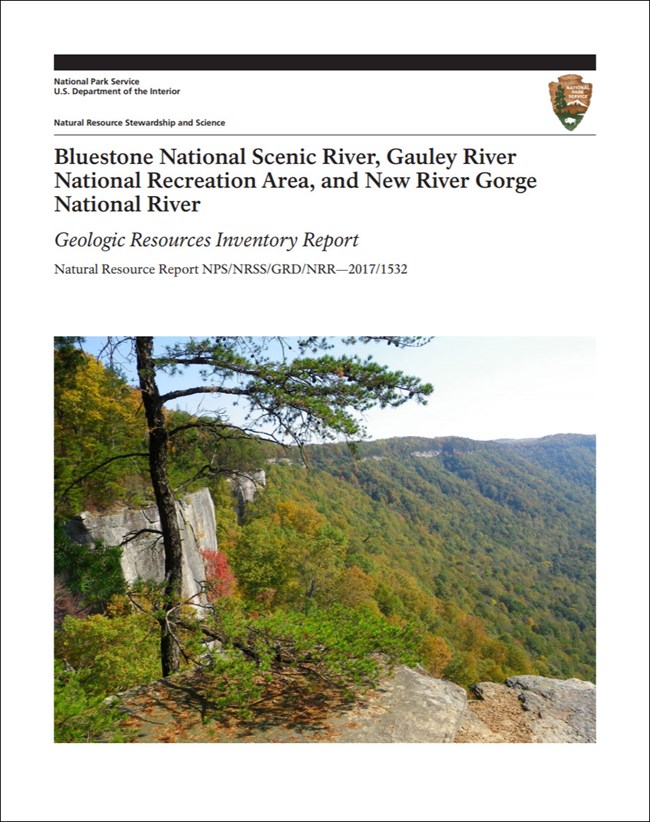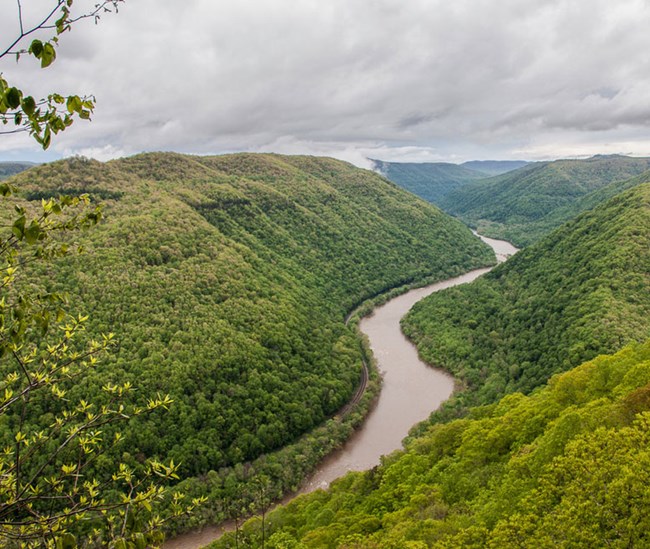Last updated: July 11, 2024
Article
NPS Geodiversity Atlas—New River Gorge National River, West Virginia
Geodiversity refers to the full variety of natural geologic (rocks, minerals, sediments, fossils, landforms, and physical processes) and soil resources and processes that occur in the park. A product of the Geologic Resources Inventory, the NPS Geodiversity Atlas delivers information in support of education, Geoconservation, and integrated management of living (biotic) and non-living (abiotic) components of the ecosystem.

Introduction
New River Gorge National Park and Preserve (NERI) stretches from Hawks Nest State Park near Cotton Hill more than 85 km (53 mi) along the free-flowing New River as far upstream as the town of Hinton in Fayette, Raleigh, and Summers Counties, southern West Virginia. Established as an NPS park unit on November 10, 1978 and upgraded to national park status on January 20, 2021, NERI encompasses approximately 29,212 hectares (72,186 acres) of abundant natural, scenic, historic, and recreational features. The rugged, whitewater New River is among the oldest rivers on the continent (Anderson 2017). The resources of NERI are dominated by the deepest and longest gorge in the Appalachian Mountains populated by numerous rapids, including the Grassy Shoals, Quinnimont, Silo, Surprise, Lower and Upper Railroad, Keeneys, Double Z, Dudleys Dip, Greyhound, Millers Folly, and Fayette Station rapids (Thornberry-Ehrlich 2017). The landscape at NERI emphasizes the area’s cultural significance, from the railroads that provided access to the rugged, isolated territory in 1872, to the numerous coal mines, towns, settlements, and bridges (Thornberry-Ehrlich 2017).
Geologic Setting
The bedrock geology of New River Gorge National Park and Preserve consists of Mississippian and Pennsylvanian-age sedimentary rocks that include the Bluefield, Hinton, Princeton, Bluestone, Pocahontas, New River, Kanawha, and Allegheny Formations. Sedimentary rocks at NERI provide clues to the geologic past and record deposition in a variety of ancient fluvial to nearshore depositional environments in the Appalachian basin. Development of the Appalachian basin began during the Taconic Orogeny, the first of a series of mountain-building events that culminated in the construction of the Appalachian Mountains. Over the course of geologic time, the New River carved down through the uplifted rock to form a spectacular landscape of rock-rimmed deep gorges, cascading waterfalls, stirring rapids, stunning vistas, and forested slopes (Thornberry-Ehrlich 2017). The gorge exposes up to 975 m (3,200 ft) of sandstone and shale. In the lower gorge, the river cuts through the resistant Nuttall Sandstone Member of the New River Formation, a unique sandstone type that is almost pure quartz.
Regional Geology
New River Gorge National River is a part of the Appalachian Plateaus Physiographic Province and shares its geologic history and some characteristic geologic formations with a region that extends well beyond park boundaries.
- Scoping summaries are records of scoping meetings where NPS staff and local geologists determined the park’s geologic mapping plan and what content should be included in the report.
- Digital geologic maps include files for viewing in GIS software, a guide to using the data, and a document with ancillary map information. Newer products also include data viewable in Google Earth and online map services.
- Reports use the maps to discuss the park’s setting and significance, notable geologic features and processes, geologic resource management issues, and geologic history.
- Posters are a static view of the GIS data in PDF format. Newer posters include aerial imagery or shaded relief and other park information. They are also included with the reports.
- Projects list basic information about the program and all products available for a park.
Source: NPS DataStore Saved Search 3030. To search for additional information, visit the NPS DataStore.
A NPS Soil Resources Inventory project has been completed for New River Gorge National River and can be found on the NPS Data Store.
Source: NPS DataStore Saved Search 3077. To search for additional information, visit the NPS DataStore.
GRI Geology Image Gallery

Related Links
Related Articles
New River Gorge National River
National Park Service Geodiversity Atlas
The servicewide Geodiversity Atlas provides information on geoheritage and geodiversity resources and values within the National Park System. This information supports science-based geoconservation and interpretation in the NPS, as well as STEM education in schools, museums, and field camps. The NPS Geologic Resources Division and many parks work with National and International geoconservation communities to ensure that NPS abiotic resources are managed using the highest standards and best practices available.

